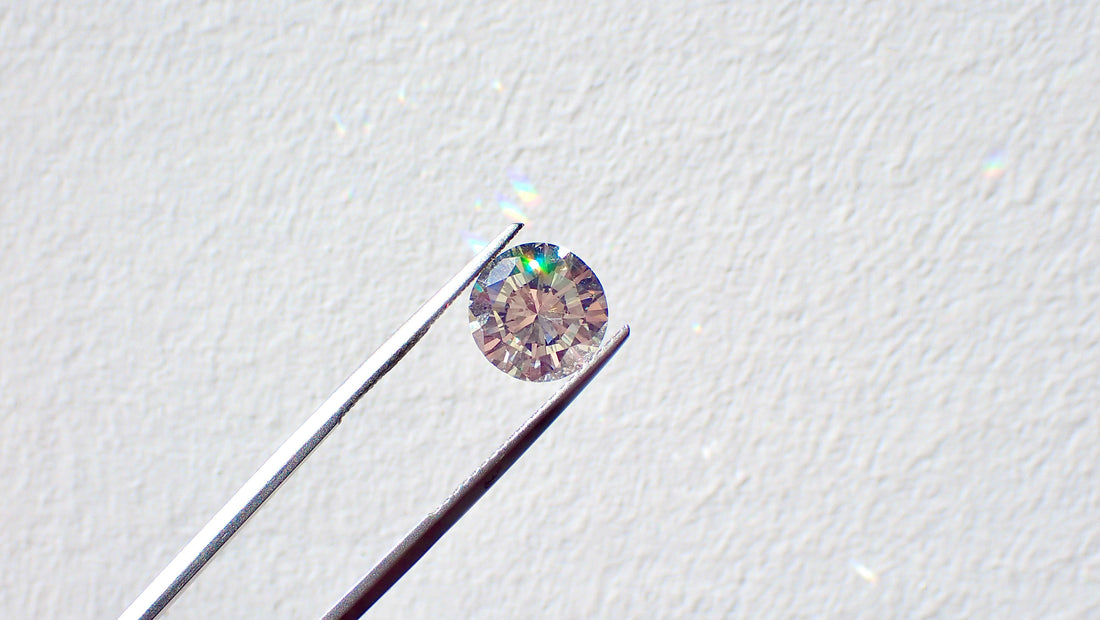In the past six years, the synthetic diamond trade has exploded in popularity and, naturally, there’s been pushback from the traditional diamond industry.
According to Fortune, in 2023, De Beers cut prices on select ranges of diamonds by up to 40% to counteract the fall in sales they experienced due to more affordable lab-grown diamonds chipping away at its market share.
If you’re still on the fence about choosing lab diamonds vs "real" diamonds, then read on to clear up misconceptions and find out whether lab diamonds or real diamonds are right for you.
What is a Diamond?
A diamond is a highly concentrated form of carbon arranged in a crystalline structure. Diamonds naturally form within the earth's crust over millions of years under the right conditions - lots of pressure and lots of heat.
For thousands of years, diamonds have been mined and traded by people in the ancient world. Originally, diamonds were believed to only be found in the Indian subcontinent, but
They are also known for their extreme hardness. This comes down to the way that the carbon atoms line up when the diamond is forming. The crystal structure of a diamond is isometric, meaning that its carbon atoms bond together in the same way in every direction.
It’s this hardness that makes diamonds very useful for practical purposes like sawing, cutting, grinding, and drilling. It’s also the reason why synthetic diamond manufacturing processes were developed back in 1954 by General Electric.
What is a Lab Diamond?
Lab-grown or lab-created diamonds are diamonds created using methods that mimic the natural diamond-forming process.
The result is a precious stone that is identical to a natural diamond in every way and just like natural diamonds, lab diamonds are available in a range of colours, clarities, cuts, and carats.
There are two types of lab diamond-forming processes, CVD (Chemical Vapour Deposition) and HPHT (High-Pressure, High-Temperature):
HPHT Method
The HPHT method uses high pressure and high temperature to grow diamonds in a lab. A small diamond piece, called a seed, is surrounded by carbon, often graphite.
This setup is then exposed to temperatures around 1400-1600°C and pressures like those found many kilometres underground.
Over a few days or weeks (depending on the size), the carbon turns into a diamond around the seed.
CVD Method
The CVD method grows diamonds from a gas, usually methane, in a special chamber.
A diamond seed is placed inside, and the chamber is filled with the gas and heated to about 800-1000°C, but at a lower pressure than HPHT.
The gas is made to break apart, and the carbon atoms from the gas stick to the seed and gradually form a diamond.
Both HPHT and CVD create real diamonds; the difference is mainly in how they're made. Each has its benefits and can produce beautiful, high-quality diamonds.
What are the 4 Cs?
All diamonds are graded according to the 4C - clarity, cut, colour, and carat. These factors look at the size, quality, and brilliance of the stone.
Clarity:
Clarity refers to the absence of inclusions and blemishes. Natural diamonds are formed under extreme pressure and heat, often leading to unique birthmarks, either internal (inclusions) or external (blemishes).
Clarity is graded on a scale from Flawless (no inclusions or blemishes visible under 10x magnification) to Included (inclusions and/or blemishes are obvious under 10x magnification and may affect transparency and brilliance).
Cut:
The cut of a diamond determines its brilliance, sparkle, and overall aesthetic appeal. It's all about how well the diamond's facets interact with light.
Precise artistry and workmanship are required to fashion a stone so its proportions, symmetry, and polish deliver the magnificent return of light only possible in a diamond. The quality of the cut is graded from Excellent to Poor.
Colour:
Colour (actually) refers to the lack of colour in diamonds. The diamond colour grading scale ranges from D (colourless) to Z (light yellow or brown). Colourless diamonds are the most desirable since they allow the most refraction of light (sparkle).
As diamonds introduce more colour, they usually decrease in value, though there are exceptions like fancy coloured diamonds (blues, pinks, yellows) which are valued for their hue.
Carat:
Carat weight measures a diamond's apparent size. One carat is defined as 200 milligrams. The carat is divided into 100 points to allow very precise measurements to the hundredth decimal place.
The weight of a diamond has a significant impact on its value, but two diamonds of equal carat weight can have very different values (and prices) depending on three other factors of the 4Cs: clarity, colour, and cut.
What Is the Difference Between Lab-Grown and Natural Diamonds?
Lab-grown and natural diamonds are identical in form and optics. They cannot be distinguished from one another without some serious equipment to detect the levels of nitrogen in the stone.
💡Remember: Lab-grown diamonds shouldn’t be confused with cubic zirconia or moissanite. These are completely different stones that mimic the look of a diamond, while lab-grown diamonds are actual diamonds.
Besides the physical properties of lab vs natural diamonds, three other areas of difference set these types of diamonds apart. Let’s take a look at them in more detail.
Costs
Lab-grown diamonds are significantly more affordable than their natural counterparts. This is because the resources needed to mine diamonds are huge.
According to the Minerals Council of South Africa, on average, it takes 250 tonnes of ore to be mined to get a single-carat gem-quality polished diamond.
Compare this process to the costs of a CVS or HPHT machine and you can understand why the price of lab-grown diamonds is much less than natural mined diamonds.
Across the board, lab-grown diamonds are considerably more affordable than natural diamonds regardless of the 4 C’s – clarity, cut, colour, and carat. For example, here are two similar stones:
|
Oval Cut Lab Grown Diamond 0.73 Carat E/VS2 |
Oval Cut Natural Diamond 0.73 Carat E/VS2 |
 |
 |
|
Retail Price: R7,499.00 |
Retail Price: R43,215.00 |
Availability and Variety
Availability
The market for lab-grown diamonds has seen a significant increase in availability and variety over the past few years.
Unlike natural diamonds, which are limited by geographic location and the resource-intensive process of mining, lab diamonds can be created anywhere there is access to the necessary technology.
This means that manufacturers can produce a steady supply of diamonds to meet growing consumer demand.
Variety
Lab-grown diamonds are not only available in traditional white but also in a spectrum of colours including pink, blue, and yellow.
These colours are achieved through controlled modifications during the growth process, which would be rare and extremely costly in natural diamonds.
Sizes range from very small to several carats, making lab diamonds accessible for a wide range of jewellery applications.
Perception and Social Acceptance
Lab diamonds are becoming more mainstream for consumers who want beautiful jewellery at a more affordable price. This is especially true for people who are conscious of the ethical concerns and environmental impact of diamond mining operations.
Jewellers and designers have started to prominently feature lab-grown diamonds in their collections, further cementing their status within the industry.
The younger demographic, in particular, has shown a strong preference for these diamonds, valuing sustainability and ethical considerations over traditional notions of rarity and luxury. According to Forbes, couples aged 18 to 34 are significantly more likely to buy lab-grown diamonds, with 37% opting for them, compared to just 24% of shoppers aged 35 and above.
While some stigma is still associated with lab-grown diamonds, mainly from purists and traditional market segments, the trend is moving towards broader acceptance.
The Bottom Line
It's clear that lab-grown diamonds offer a compelling alternative to natural diamonds, characterised by their affordability, ethical production, and environmental benefits.
While they are identical in physical, chemical, and optical properties, the choice between lab-grown and natural diamonds ultimately boils down to personal values and preferences.
Lab diamonds present an innovative solution to many of the issues associated with diamond mining, without compromising on the beauty or quality of the stone.
Whether you're drawn to lab-grown diamonds for their ethical implications, their lower price point, or simply the science behind their creation, it's an exciting time to be exploring the world of diamonds.
Ready to find your perfect stone? Explore our range of certified lab grown and natural diamonds.

